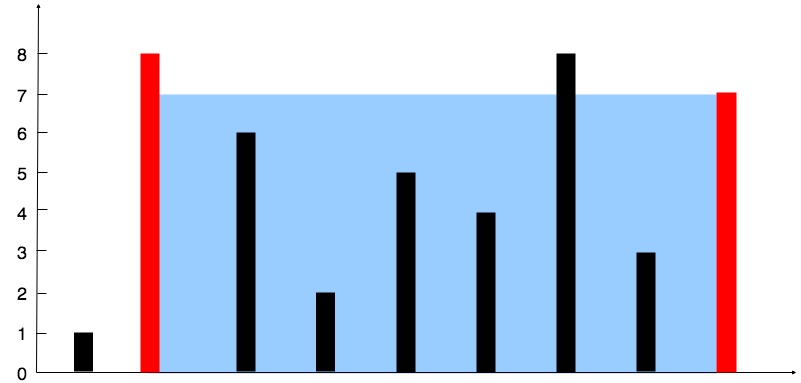You are given an integer array height of length n. There are n vertical lines drawn such that the two endpoints of the ith line are (i, 0) and (i, height[i]).
Find two lines that together with the x-axis form a container, such that the container contains the most water.
Return the maximum amount of water a container can store.
Notice that you may not slant the container.
Example 1:

Input: height = [1,8,6,2,5,4,8,3,7] Output: 49 Explanation: The above vertical lines are represented by array [1,8,6,2,5,4,8,3,7]. In this case, the max area of water (blue section) the container can contain is 49.
Example 2:
Input: height = [1,1] Output: 1
Constraints:
n == height.length2 <= n <= 1050 <= height[i] <= 104
A:
----------------------------------第三遍-----------------
上面都是O(n^2)的复杂度,但是,有个O(n)的复杂度的。
下面是分析 (引用)find the maximum value of (i-j)*min( ai , aj ).
Set two pointers, point to begin and end. Move the pointer which points to the smaller element in array. 因为我们一开始都已经是最大的间距了。 因此左右两个pointer中,小的那个,以及不可能有更好的相乘结果了. 因此就可以调整它
Set two pointers, point to begin and end. Move the pointer which points to the smaller element in array. 因为我们一开始都已经是最大的间距了。 因此左右两个pointer中,小的那个,以及不可能有更好的相乘结果了. 因此就可以调整它
https://leetcode.com/problems/container-with-most-water/solutions/5139915/video-simple-two-pointer-solution/
Proof:Because the contain volume is decided by the shorter line between two.
Since ai is lower than aj, so there will be no jj < j that make the area from i, jj is greater than area from i,j so the maximum area that can benefit from i is already recorded.
class Solution {public:int maxArea(vector<int>& height) {int i = 0, j = height.size() - 1, res = 0;while (i < j) {res = max(res, (j - i) * min(height[i], height[j]));if (height[i] <= height[j]) {i++;} else {j--;}}return res;}};
------------------------------------------- 第4遍。-------------------
考虑到,对于左边的bar, 如果左边有个更高的,就不需要保留它。 因此所生成的 potential left bar, 只会是从左向右 逐个增加
同理,对于右边的bar,从后往前看, 如果后面有比他高的, 就不需要考虑它了。
最后再全部找找对应的解决方案
class Solution {
public:
int maxArea(vector<int>& height) {
int n = height.size();
// for left side, ignore any bar is lower then a bar on its left
vector<pair<int, int>> L; // for a pair, 0 is for index, 1 for value
for(int i =0; i < n; i++ ){
if(i==0 || height[i] > L.back().second ){
L.push_back(pair{i,height[i]});
}
}
// for right side, ignore any bar is lower then a bar on its right
vector<pair<int, int>> R;
for(int j =n-1; j>=0 ; j-- ){
if(j== n-1 || height[j] > R.back().second ){
R.push_back(pair{j, height[j]});
}
}
// check all possible combinations
int res = 0;
for(auto& pl : L){
for(int i =0; i< R.size(); i++){
if(R[i].first <= pl.first)
break;
res = max(res, (R[i].first - pl.first) * min(R[i].second, pl.second));
}
}
return res;
}
};
思路: 就是 一个个往上加line。 *****************但是这样会超时*******
public class Solution {
public int maxArea(int[] height) {
// Note: The Solution object is instantiated only once and is reused by each test case.
int maxWater = 0;
int n = height.length ;
if(n<=1 ) {
return maxWater;
}
for(int i =1;i< n ;i++){
int maxEndHere = maxEndAtI(height,i,maxWater);
maxWater = maxWater>maxEndHere?maxWater:maxEndHere;
}
return maxWater;
}
private int maxEndAtI(int[] height, int i, int maxWater){
// return the max water that returns at current position
if( height[i] * i < maxWater|| height[i] == 0 ){ // height[i] is too low to exceed former maxWater
return 0;
}
//start from the possible left position
int leastLength = maxWater/height[i];
int leftLineMostRighPos = i - leastLength;
int curMaxWater = maxWater;
for(int j= leftLineMostRighPos; j>=0;j--){
int curWater = Math.min(height[j],height[i])*(i-j);
if(curMaxWater < curWater){
curMaxWater = curWater;
}
}
return curMaxWater;
}
}
Mistakes:
1:又一次出现了,除零的问题。。 ╮(╯▽╰)╭
-------------------第二遍----------
1: 题意理解错误, 应该是 2条line, 而不是bar, 因此,即使输入是【1,1】的时候, 也可以盛1单位的水。
2: 题意理解错误, 两条line,中间即使是有个比他们都高的, 也不碍事。
例如,输入是:[1,2,1] 的时候,输出应该是2、
3: 哎, again, 出现了除零的问题。 ----------Tiger, 记住,只要是出现除数, 就要检查其值是否为0.
Learned:
1: 即使是int类型的变量, 如果要 调用的话,也需要事先initialize。
No comments:
Post a Comment